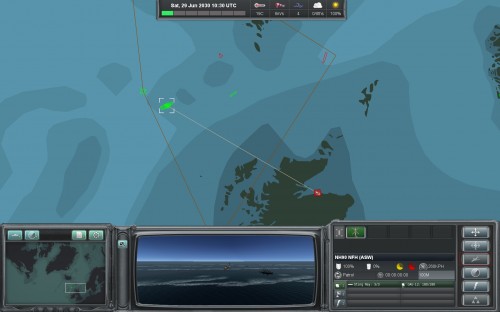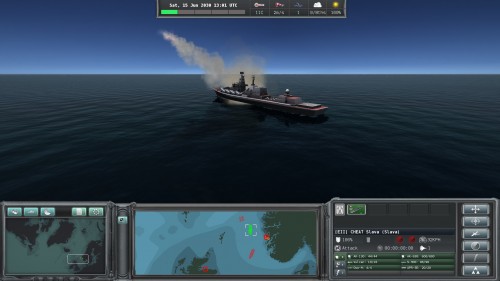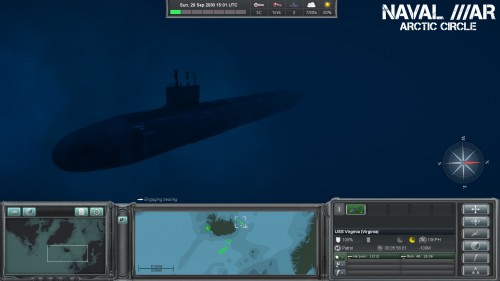Naval War: Arctic Circle – the verdict
Cold, wet, and liable to explode into violence at a moments notice. But that’s enough about Hull. Far north of the tropical climates found in modern gaming, Naval War: Arctic Circle takes the intriguing concept of modern naval warfare and presents a complicated yet accessible simulation, stumbling just short of a fine execution.
Portraying a near-future clash between Nato and Russian forces in the cold seas of the Arctic circle, Naval War is a light-weight command-level simulation of modern sea combat. Taking inspiration from Introversion’s Defcon, it presents clear unit icons and simple controls for the player. But where the latter benefited from a chess-like level of unit simplification, Paradox have taken the opposite approach by introducing a massive number of different units with unique advantages and disadvantages. Whilst this does provide for more options – naval enthusiasts will applaud the large number of missile variations – it can leave people wondering what it’s all for.
Naval Warfare benefits from a simple interface. The main game window is dominated by the combat map, where units are controlled via a classic RTS style. Left-click to select a unit, and right-click to issue orders. Sounds simple enough in theory, but the implementation is hindered by additional sensor controls and weapon systems hidden away in numerous side menus. Some odd design decisions can often make giving simple orders a surprising chore, especially during the heat of battle.
Beneath the combat map an additional window shows a close-up of your selected unit. The models, although well detailed, are hindered somewhat by limited animations and their tendency to wander through mountain ranges and coastal cliffs without respect for the laws of physics. Aircraft lurch into the sky on take-off, and when told to stay on location spin uncontrollably like a top. It’s a shame that Paradox weren’t brave enough to abandon the rendering window altogether in favour of enlarging the map area, as the game could easily have lost the flawed 3D engine and not suffered in the slightest.
The problem of units wandering through chunks of landscape is not restricted to the close-up window either. My last attempt to destroy an enemy submarine by missile attack was hampered by the sub-commander’s cunning strategy of concealing his submarine several hundred metres inland, deep underground. Despite my ferocious bombardment of several thousand tonnes of limestone, I was forced to abandon the attack and restart the mission.
As a result, combat is not Naval War’s strongest point. Paradox has made the rare decision to concentrate instead on the scouting and reconnaissance aspects of warfare, and certainly excels in this area. Contacts that appear on your map may or may not be hostile units, with neutral shipping and aircraft criss-crossing the narrow contested seas of the northern passage. Act without full information and you risk destroying civilian aircraft, shipping or the occasional whale. On the other hand, spend too long gathering full intelligence and you could end up on the wrong end of a concentrated attack.
Not content with a large number of naval vessels to get to grips with, armchair captains will also need to juggle their time ordering air units, deploying combat patrols and radar units to seek out and identify unknown enemy contacts. There is a certain degree of tension in watching your fighters intercept a deadly incoming bomber, but enemy aircraft have a tendency to trickle in your direction in low numbers, so large formations of fighters will have little difficulty in keeping the skies clear.
The problems come once you start to formulate your plans. Whilst Defcon had a time compression system that rapidly accelerated time, Naval War has one that increases the passage of time from ‘Almost Stationary’ to ‘Lethargically Slow’. Whilst I’m in no way suggesting all games should be blinding fast APM click-fests, any plan takes a monumentally long time to come to fruition. The problem is further exacerbated when you go to save mid-mission. You can’t. For a game with such agonisingly slow movement times to have no save feature seems like a deliberate kick in the teeth to all gamers with young children.
Overall, Naval War: Arctic Circle suffers from a confusion of identity. It isn’t sure whether it wants to be a simple representation of naval combat, or a more in depth simulation of a conflict between two well-equipped military forces. As a result, it’s too complicated for the Defcon crowd, but too simplistic for more hard-core war gamers. Hampered by an unforgivable lack of mid-mission saving and flawed visuals, it occupies a disappointing middle-ground between the two. However, if you have the time to devote to it fully and enjoy complex naval simulations, beneath the flawed exterior you’ll find a small yet well formed gem.
Verdict: On Target
Platforms Available – PC
Platform Reviewed – PC
For more information on our scoring policy please read this post


